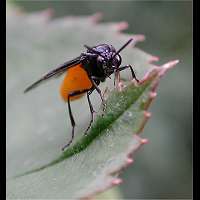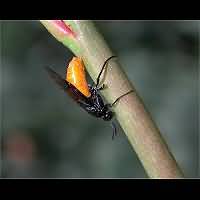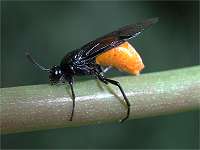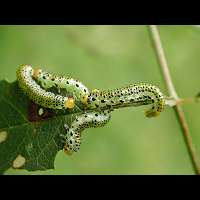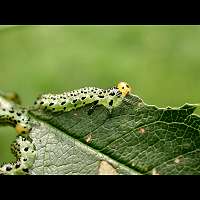[All pictures of garden wildlife on this page are thumbnails. Click on any thumbnail for a large format to be displayed.]

Large Rose Sawfly (Arge pagana)
| Taxonomy | ||||||
|---|---|---|---|---|---|---|
| Kingdom: | Phylum: | Class: | Order: | Family: | Genus: | Species: |
| Animalia | Arthropoda | Insecta | Hymenoptera | Argidae | Arge | A. pagana |
There are actually two species referred to as the Large Rose Sawfly. Arge pagana is the common species, Arge ochropus is rarer. The Large Rose Sawfly depicted on this page is Arge pagana though, so everything else in this article is about that particular species. The Large Rose Sawfly is a quite beautiful and shiny animal. The animal is entirely black, except for the abdomen which is yellowish orange. Because of the dark, blackish wings, which are kept over the abdomen, the orange colour may not always be clearly visible. The legs are usually entirely black as well. The animals are not capable flyers, slowly flying about with the legs hanging down. In flight they are quite similar to to some flies, such as the St Mark's Flies, appearing in spring as well. Males can be told apart from the females by looking at the antennae. Males have wire-like antennes, which are the same size just about everywhere. Females have antennae which get slighter thicker going upwards. The Large Rose Sawfly is on the wing in spring and early summer mainly. Depending on the temperatures most are seen from March to June. Like all Sawflies female Large Rose Sawflies are in possession of a little saw. With it they make rectangular cuts in the fresh shoots of the host plant. In the cut a bunch of eggs is being deposited. The larvae hatch quite quickly and move in a group to the freshly emerged leaves. Young larvae stay together for quite some time, capable of eating the entire shoot. Older larvae lead a more single life and eat from older leaves as well. The larvae are very similar to caterpillars and green with black dots and points. When they feel threatened they assume the so-called S-position. This can be seen in many other sawfly larvae as well. To pupate a firm whitish cocoon is spun near or in the soil. The cocoon actually has two covers. The inner one is smooth and firm. The outer cover has the design of a net. It is the pupa overwintering. The larvae are found on wild and cultivated roses.
The Large Rose Sawfly is a common species all over Britain. Usually it appears in small groups. The larvae have very many anemies and are usually quickly eaten bij bugs and their larvae. There are also a number of parasitic wasps highly interested in Large Rose Sawfly larvae and cocoons. Occassionally though numbers are very high indeed and a lot of damage can be done to roses. Even though some plants may be so heavily infested they die, this is quite exceptional. In most cases no action needs to be taken. The natural enemies appear within two weeks after the outbreak and will quickly limit the number of sawfly larvae.

© Copyright 1998-2024 gardensafari.net (Hania Berdys)

 English / engels
English / engels  Dutch / nederlands
Dutch / nederlands
